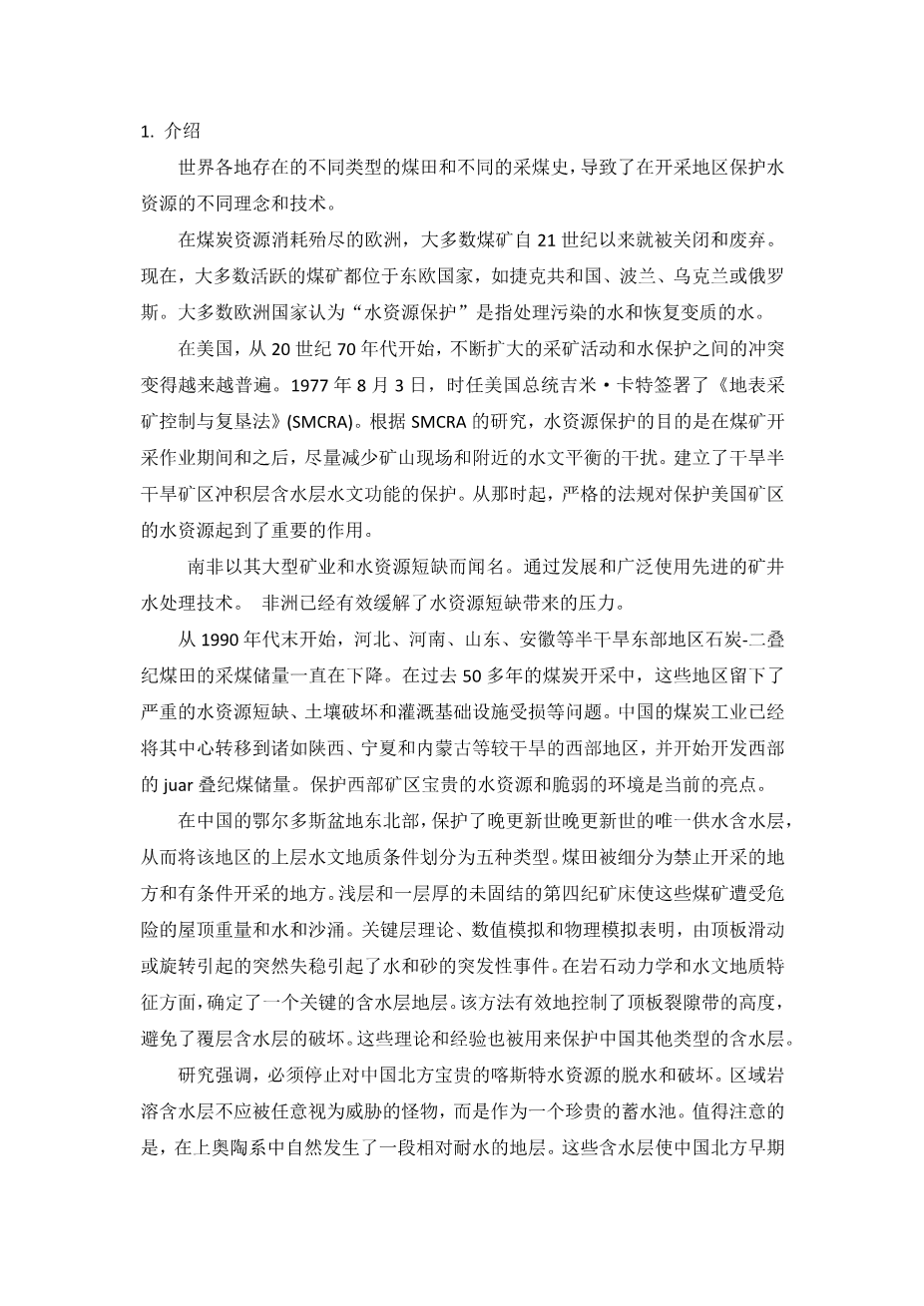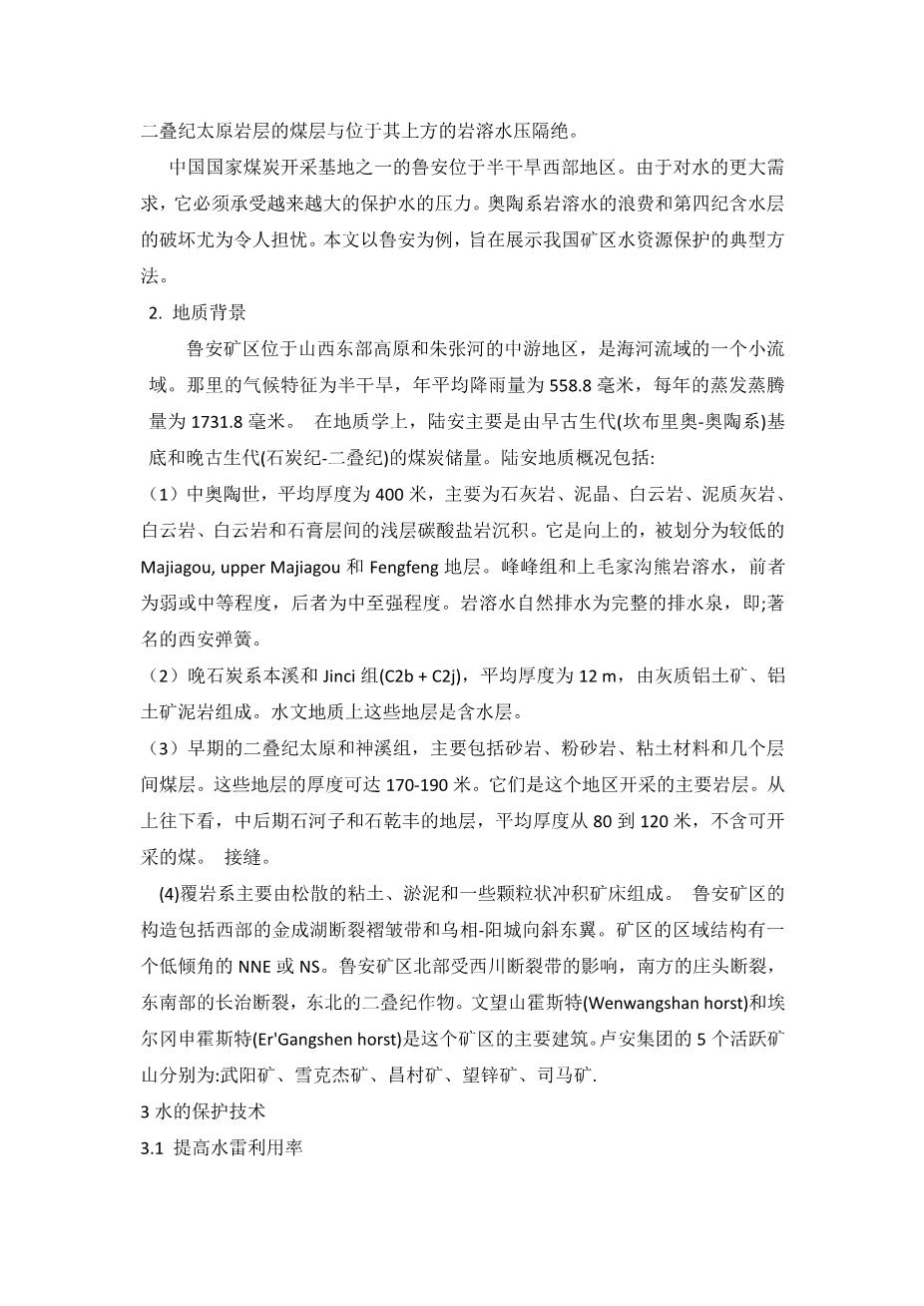1. Introduction
The different types of coalfields and various coal mining histories that exist around the world have led to different philosophies and technologies for the protection of water resources in the mined areas.
In Europe, where the coal resources are used up, most coal mines have been closed and abandoned since the 21st century. Now most active coal mines are located in the Eastern European countries such as the Czech Republic, Poland, Ukraine, or Russia . Most European countries consider 'water resource protection' to mean treating polluted water and restoring deteriorated water.
In the USA conflicts between expanding mining activities and water protection have become more common since the 1970#39;s. On August 3, 1977, then president Jimmy Carter signed the Surface Mining Control and Reclamation Act (SMCRA). According to SMCRA the aims of water resource protection are to minimize disturbance of the prevailing hydrologic balance at the mine site, and nearby off site, both during and after the coal mining operations. Protection of hydrological functions of the alluvium aquifer in arid and semi-arid mining areas was established . Stringent regulations have played an important role in protecting water resources in mining areas of the USA since then.
South Africa is well-known for its large mining industries as well as its scarcity of water resources. By developing and widely using state-of-the-art mine water treatment technologies South Africa has effectively mitigated the pressure from water shortage.
In China extractable coal reserves of the Carboniferous-Permian coal fields in the semiarid eastern regions such as Hebei, Henan, Shandong, and Anhui, have been dropping since the end of the 1990#39;s. Over 50 years of coal exploitation have left these regions with a legacy of severe water shortage, destroyed soils, and damaged irrigation infrastructures . The coal industry of China has shifted its center to the drier western regions such as Shaanxi, Ningxia, and Inner Mongolia, and begun to develop the western Juarassic coal reserves . Protecting the valuable water resources and fragile environment in the western mining area stands out as a current highlight.
Protecting the sole water supply aquifer of the late Pleistocene Sa-la-wu-su formation in the north-east of the Ordas basin, China, has led to classify the overlying hydro-geologic conditions of this region into five types . The coal fields have been subdivided into those where extraction is forbidden and those where extraction is conditional . Shallow depths and a thick unconsolidated over layer of Quaternary deposits causes these coal mines to suffer hazardous roof weights and water and sand gushing . The key strata theory and numerical and physical simulations have shown that sudden instability caused by roof blocks sliding or rotating has triggered water and sand inrush incidents. A key aquifuge strata was defined with regard to both rock dynamics and hydro-geologic features. This was effectively used to control the height of the roof fracture zone and to avoid destruction of the overlying aquifers. These theories and experience also are used to protect other types of aquifers in China .
Studies have stressed that it is imperative to stop de-watering and damaging the valued karst water resources in northern China . The regional karst aquifers should not be arbitrarily treated as a threatening monster any longer, but rather as a treasured water reservoir. It is worth noting that a section of relatively water resistant strata naturally occurs in the upper Ordovician group . These aquifuges allow the coal seams of the early Permian Taiyuan formations in northern China to be isolated from the karst water pressure located above them .
Lu#39;an, one of the state coal mining bases in China, is located in the semiarid western region. It must bear increasingly heavier pressures for protection of water due to greater demands for water. The waste of Ordovician karst water and damage to the Quaternary aquifer are particularly of concern. This paper, taking Lu#39;an as an example, is intended to show typical ways of protecting water resources in Chinese mining areas.
2. Geological setting
The Lu#39;an mining area lies in the eastern Shanxi plateau and the middle reaches of the Zhuozhang river, a sub-watershed of the Haihe river. The climate there is characterized as semiarid with a mean annual rainfall of 558.8 mm and an annual evapo-transpiration of 1731.8 mm.
Geologically, Lu#39;an is principally underlain by the early Palaeozoic (the Cambrian-Ordovician) basement and the late Palaeozoic (Carboniferous-Permian) coal reserves. The geologic profile of Lu#39;an consists of:
(1)The middle Ordovician (02) with an average thickness of 400 m, which is chiefly neritic carbonate deposits of limestone, micrite, dolomitic limestone, argillaceous limestone, dolomicrite, dolomite, and gypsum inter-beds. It is upwardly subdivided into the lower Majiagou, upper Majiagou and Fengfeng formations. The Fengfeng formation and the upper Maojiagou bear karst water, the former to a weak or medium extent and the latter to a medium to strong degree. The karst water naturally discharges as complete drainage springs, i.e.; the well-known Xi#39;an Springs.
(2)The overlying late Carboniferous Benxi and Jinci formations (C2b C2j), which are on average 12 m thick and are comprised of gray alumyte, bauxitic mudstone. Hydro-geologically these formations act as aquifuges.
(3)The overlying early Permian Taiyuan and Shenxi formations, which mainly comprise sandstone, siltstone, clay materials, and several inter-bedded coal layers. These formations add up to a thickness of 170-190 m. They are the main layers mined in this region. Upwardly, the overlying middle to late Permian Shihezi and Shiqianfeng formations, with an average thickness from 80 to 120 m, contain no workable coal
seams.
(4)The
全文共14572字,剩余内容已隐藏,支付完成后下载完整资料


英语原文共 5 页,剩余内容已隐藏,支付完成后下载完整资料
资料编号:[12470],资料为PDF文档或Word文档,PDF文档可免费转换为Word
您可能感兴趣的文章
- 两种水处理厂活性污泥生物群落生物指示物真核生物的比较:一个案例研究外文翻译资料
- 针叶凋落物挥发性有机化合物的顶空-固相微萃取技术分析外文翻译资料
- 流动注射-在线固相萃取化学发光系统测定天然水中痕量铜外文翻译资料
- 电感耦合等离子体原子发射光谱法,火焰原子吸收光谱法和紫外 – 可见分光光度法测定制革废水中的总铬外文翻译资料
- 表面改性对活性炭吸附苯酚和2,4-二硝基苯酚的影响外文翻译资料
- 伊斯坦布尔一级和三级城市污水处理厂的成本比较评价外文翻译资料
- 基质固相分散(MSPD)是测定粉尘中多溴二苯醚(PBDEs)的简单有效的样品制备技术外文翻译资料
- 乙酰胆碱酯酶是广谱有机环境污染物的潜在生物标志物外文翻译资料
- 纳米材料导论概述:广谱应用外文翻译资料
- 植物和粪便生物炭的性质及其对邻苯二甲酸二丁酯和菲的吸附外文翻译资料


